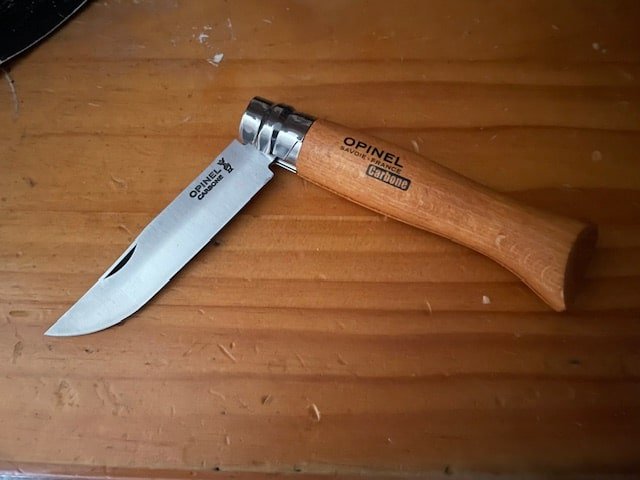
“Dwell on the beauty of life. Watch the stars, and see yourself running with them.” ~Marcus Aurelius
I recently acquired an Opinel No. 9 with a carbon steel blade. Opinel makes their “Carbone” series with XC90 steel, which is also known as 1086.
It is a mildly high-carbon steel with between .80% and .93% carbon (which gives it its name). It also contains a smidge of manganese for strength, along with traces of sulfur and phosphorus.
What’s missing? Chromium, which along with nickel, is usually added to alloys to make them stainless. Consequently, knives made from 1086 steel (and all steels in the 10XX family, like 1045 and 1095) will rust.
Now, you can be meticulous in your use and care of a 1086 knife, and keep it diligently oiled in order to prevent rust, but there’s something else you can do which can serve as a hedge against mildly corrosive influences.
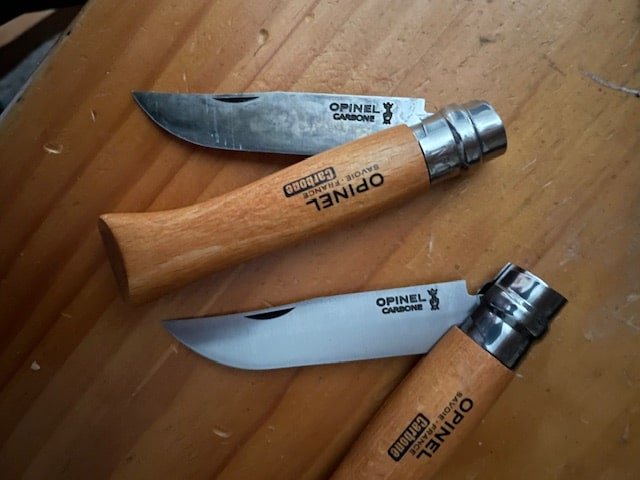
It’s encouraging the blade to develop ahead of schedule. You can see the difference between a fresh carbon steel blade without a patina (my new Opinel No. 9) next to a knife that has a mature patina (my older Opinel No. 8) both in the picture above.
Here’s everything you need to know about the process of forcing a patina, starting with why you should do it in the first place.
Why Do You Want to Do This?
You landed here looking for how to force a patina on a carbon steel knife so you might already know this, but in case you don’t, here’s your primer.
First, patina is the term applied to the discolored, mottled appearance that manifests on the surface of non-stainless steel alloys over time, and with exposure to oxygen, moisture and other catalysts.
This is what it looks like
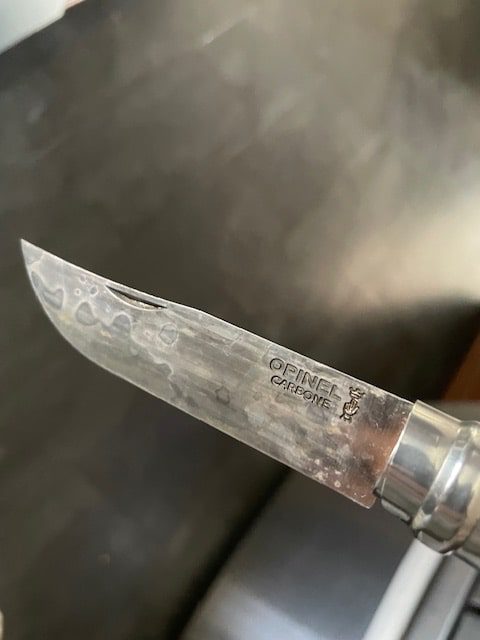
A patina, like rust, is a form of oxidation. As a general rule, oxidation is bad for steel because it causes chemical decay. It is, itself, the chemical decay.
But a thin layer of oxidation on the surface of steel is the key to preventing progressive degradation. This is how stainless steel works. By mixing chromium with the iron, a thin layer of chromium oxide forms on the surface of the steel, so the steel underneath does not rust.
This is the principle behind a patina. By encouraging a layer of patina to form on the surface of the steel, you can prevent rust from developing.
It is also worth noting that there is more than one form of oxidation, or “rust.” The two most common forms are “black rust” and “red rust.”
You’re probably familiar with red rust. It is the form of oxidation that occurs on steel that’s exposed to salt spray and other oxidative catalysts. It is destructive and rapidly eats away at steel.
Black rust is also called magnetite and actually occurs underneath red rust, though you can’t see it. It is a hard material that occurs only in low-oxygen environments, and forms more slowly than red rust.
Now, forcing a patina on a carbon steel blade, in a low oxygen environment, helps prevent the progression of red rust, and though it doesn’t entirely block red rust, does help serve as a small oxidative barrier between the steel and the atmosphere.
A patina will form on a carbon steel blade that’s been cared for properly, but it will happen slowly and over time. If you fast track it, you can help form this protective layer.
Just as importantly, a patina is as unique as a fingerprint, and no two will be exactly the same. There are aesthetic reasons to force the process as well.
So, with no further ado, here is my process for forcing a patina on a carbon steel blade.
The Technique
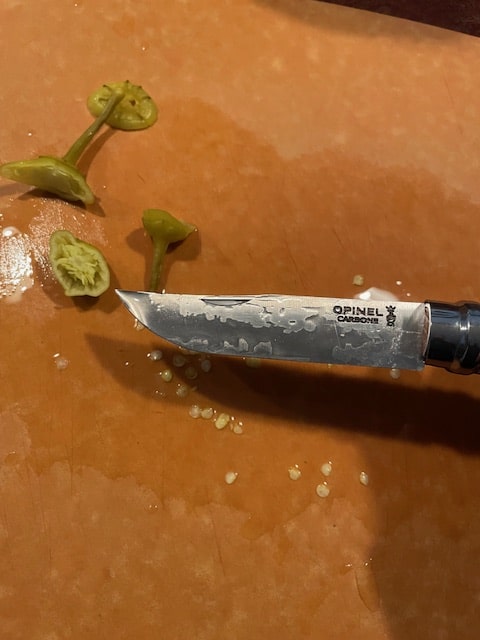
All you need for this process are some brined peppers or pickles (I’m using pickled pepperoncini) and the knife you plan to use.
Rinse off the knife and clean it. If there is a layer of oil on the blade, you will need to wash this off with soap and water as it will
hinder the formation of patina on the blade.
Once you’ve cleaned and dried the knife, simply slice a few pickles or peppers. Use a pickle or pepper coin to spread some of the acidic brine on the blade if you don’t feel there’s enough on there.
Then, just let the blade sit there with the brine on it for a few minutes. After about five minutes, you will see that some discoloration has started to form on the blade.
Once you see the pattern forming, rinse off the blade and dry it thoroughly. If you are forcing a patina on a folding blade, be meticulous about rinsing and drying, as any water or brine trapped in the pivot point will take the oxidation too far and will rust the blade.
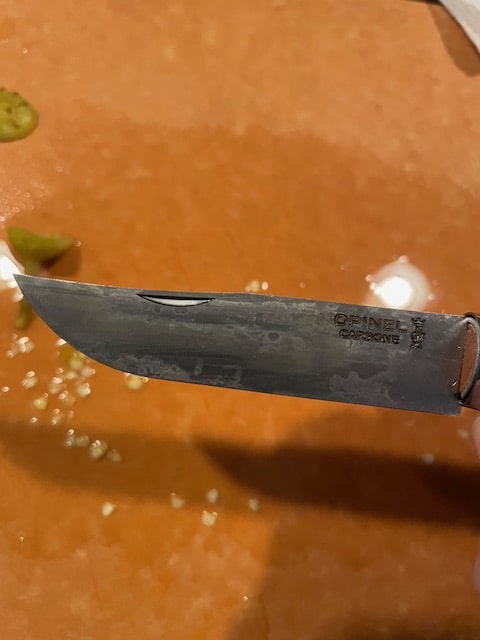
All you have to do is repeat this process a few times and you will have a rich patina on your carbon steel blade.
After a few days, and consequently a few treatments in this manner, and your knife will start to look like this:
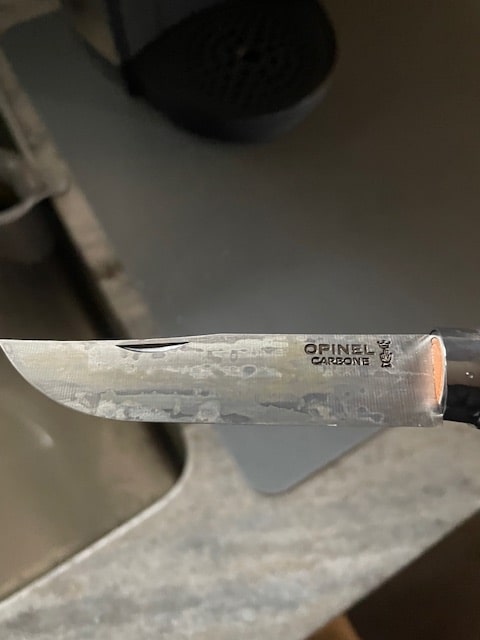
And just like that, you’ll have a rich patina on your carbon steel knife that will help insulate the blade against oxidative stress.
The reason this works is that, while the blade is under a wet coat of brine (acid) there is minimal exposure to oxygen. This allows the black rust to form while somewhat inhibiting the formation of red rust. Left too long, though, the blade would still form red rust.
Also, my technique allows me to develop a patina in layers without going too hard, too fast.
Alternative Methods for Forcing a Patina on a Carbon Steel Blade
I prefer my method for forcing a patina on a carbon steel knife because it is metered and cautious. There are other techniques that are more aggressive than mine, though. Here are some of them:
Heating up white vinegar until it is warm to the touch, soaking a paper towel in it, and then wrapping the blade and letting it sit for 10 to 30 minutes (if not longer).
Sticking the blade of the knife in mayonnaise or mustard for several hours.
Sticking the blade in an acidic fruit or vegetable like an onion, tomato, pepper, apple or pepper for several hours/overnight.
Soaking the blade in lemon, lime or orange juice for several hours.
All of these methods will work, although they are not what I have detailed here.
I do however want to close with one very important note. While a patina will protect your carbon steel blade, you can’t get lazy about keeping it clean. In other words, a blade with a patina will still rust (red rust, that is) if you put it away wet or expose it to extremely corrosive environments like marine conditions.
Therefore, be conscious about cleaning and drying your knife after use, even if it has a fully developed patina.
Stay sharp.
~The Eclectic Outfitter